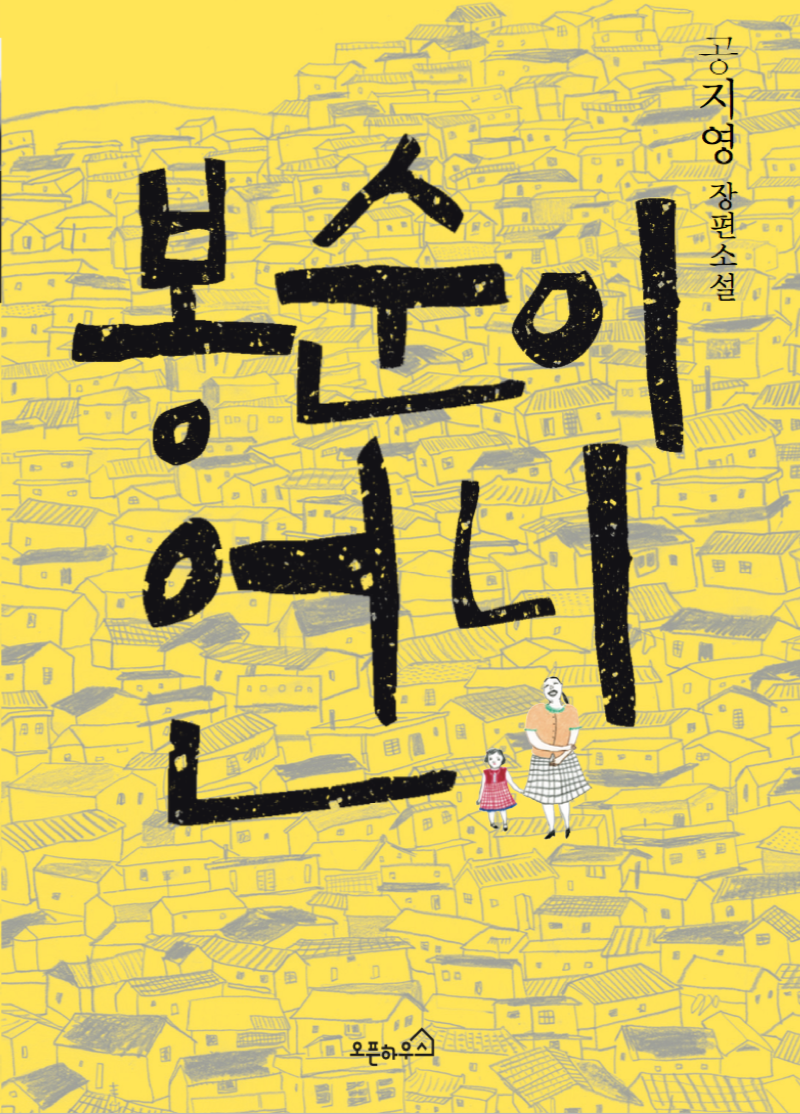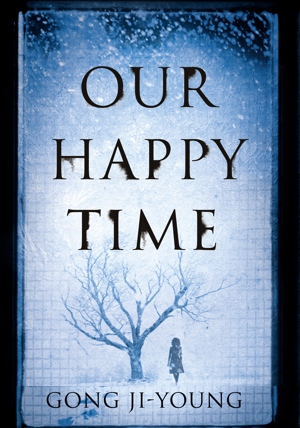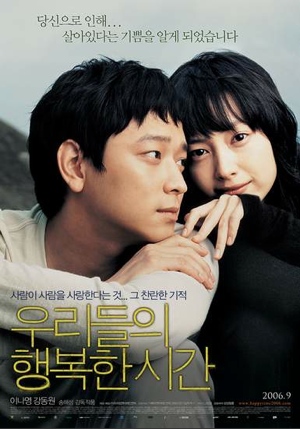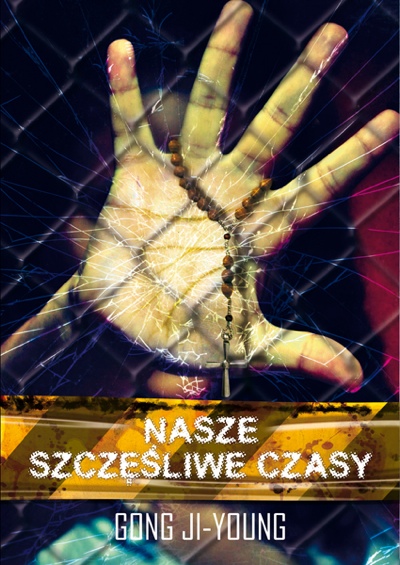Gong Ji-Young
bOOKS
My Sister Bongsoon
New Book by the author of Our Happy Time. Sold to Philippe Picquier.
My Sister Bongsoon is an autobiographical novel. Through theeyes of Jiang, a precocious five-year old girl, the author relates how Bongsoon, a live-in maid who was uneducated, unloved but innocent and hard-working like most of the maids of those days, views the emerging new world of Korean reality. There is anguish, insight, but also immense painin this novel.Gong wrote: I decided to picture Bongsoon and many other maids like her who existed in the early stages of economic growth and who were simply ignored amid the hctic development of that era. My Sisster Bongsoon is my personal reflection as a comfortable middle-class person on all those women who we just neglected!
Our Happy Time
English translation complete - by Sora Kim Russell (translator of Shin's I'LL BE RIGHT THERE). Prunsoop Publishing/Korea, 2005, 229 pages in English. World English language publication/Short Books /UK and Commonwealth, Marble. Arch Press/Simon & Schuster/US, January 2014. Sold to Editora Record/Brazil, La Esfera de los Libros/Spain, House of Books/Holland, Laguna/Serbia, Kwaity Orientu/Poland, Rye Publishing/Taiwan (also bought OUR SWEET HOME, THE CRUCIBLE).
Introducing one of Korea’s most beloved and critically acclaimed novelist’s, Ji-Young Gong has sold over 10 million books in Korea alone and most all of her books have been adapted into hugely popular films. Winner of the 2011 Yisang Literary Award, the 21st Century Literary Award, Korean Novel and Literature Prize, Oh-Young-sook Literature Prize and Special Media Award from Amnesty International for OUR HAPPY TIME. Gong has been only published in China, Thailand and Japan.
UR HAPPY TIME is a beautifully written story of the redemption of a young, condemned man and a beautiful, wealthy, young woman who have both endured extreme physical, sexual and mental abuse, suffering, and alienation during their short lives. Yu-Jung has now attempted her third suicide attempt. Her disdain for her mother and indifference to the rest of the world, isolates her from any chance for happiness. Yu-Jung also has an aunt named Sister Monica. Her aunt often goes to prison to meet with death row inmates. Sister Monica meets a new death row inmate, who asks Sister Monica if he could meet her niece Yu-Jung. Sister Monica asks Yu-Jung if she would counsel this death row inmate and Yu-Jung reluctantly agrees to do so. Yu-Jung and the death row inmate do not open up to each other immediately. Yu-Jung comes from a family of wealth and is now a professor at a university. Yet, she has never known happiness since the age of 15. The inmate that she meets, named Yun-Soo has had an even more traumatic childhood experience. He was abandoned by his parents at an early age and has had to live on the streets while caring for a younger brother. Eventually Yun-Soo ends up involved in the criminal world and gets convicted for murder. With their disparate backgrounds, Yu-Jung and Yun-Soo are still able to connect with each other, because both people know grief like few others could possibly know. As they both regain the will to live through their weekly meetings, they must now deal with their feelings for each other and come to grips with the short amount of time they have together.
The novel includes the “blue notebook,” the diary of Yun-Soo, and as the narrative progresses, we learn about his life history and what events caused him to end up where he is today. At the same time, Yu-Jung narrates her story and she finally is able to reveal the secret that has caused her such anguish, but only to Yun-Soo. They set each other free by their acts of unconditional love for each other. This is a love story that transcends love and brings the characters to personal salvation as well. In only 229 pages, Gong, writes with great passion and with an accessible style. The story of these two lovers who are allowed to meet only on Thursdays for one hour in a tiny room in the prison complex, is overwhelmingly gripping and magnificent. Part The Executioner’s Song, part Dead Man Walking, OUR HAPPY TIME is quite simply……unforgettable.
A Tall Blue Ladder
Br. Anthony translates
Reader’s Report by Sora Kim-Russell
Introduction
A Tall Blue Ladder, the latest novel from Ji-young Gong, one of South Korea’s most popular and successful female writers, offers an intimate glimpse into the world of Korean Catholicism through the eyes of a Benedictine monk.
The novel showcases Gong’s lyrical prose style and her passionate commitment to politics. Two of her previous novels, Our Happy Time and The Crucible, were successfully adapted to film, and The Crucible even led to a change in South Korean law regarding the rights of the disabled. With Tall Blue Ladder, the novel opens on what initially appears to be a story of forbidden love between Brother John, a young Benedictine monk, and Sohee, a graduate student engaged to another man, but as with many of Gong’s books, the narrative broadens to encompass larger questions of social responsibility and political engagement. Later, following a series of tragedies, Brother John is sent to collect testimonies regarding the Hungnam Evacuation of 1950, whereupon he learns the full history of his monastery, Waegwan Abbey, and the reasons for his grandmother’s lifelong devotion to the church. The novel is a stirring and poetic meditation on love, faith, and the lengths a person will go to for the sake of another.
Importance and appeal of the book
A Tall Blue Ladder has obvious and immediate appeal for anyone desiring to know more about Catholicism and the monastic order in Korea, but it also has broad appeal for general English readers as it offers a rare glimpse into a literally cloistered corner of Korean life as well as a little-known story from the Korean War. So much of what is known from the war is tragic and wrenching, which makes the tale of “Brother Marinus” and his selfless act of evacuating over 14,000 refugees to safety during the Korean War all the more important. Even in the midst of terrible violence, people can still care for perfect strangers in astonishing ways. But this is not a historical novel—the Hungnam Invasion is told as an interlude, while the main narrative is set very much in the present day. Gong’s keen eye for issues of class and inequality also lends a unique perspective on how individuals can overcome social barriers and fall in love only to have those same barriers fall back into place when reality starts to creep back in.
Ultimately, Tall Blue Ladder is more than the sum of its parts: It is not just a Korean novel, not just a romance, not just a war story, and not just a religious journey. It is a poetic and moving exploration of one man’s life, told in lush detail, and with absolutely universal themes.
Comments on format and structure
The book is divided into three parts, which each part made up of short chapters that resemble diary or memoir entries. Father Johan, a thirty-nine-year-old Benedictine priest residing at Waegwan Abbey, looks back on the events of his life ten years earlier when a series of tragedies befell him and his faith was tested. This diary-like structure with its short, intense chapters and the quiet setting of the monastery give the novel a very intimate look into the narrator’s thoughts and experiences, and this in turn gives the prose a deliberately meditative, lyrical style that comes as a welcome change from more frenetically paced works. Further, the interweaving of different characters’ stories throughout the book is intriguingly suggestive of testimony, in both the legal and religious sense—the voices in the novel bear witness to both personal and historical events, all of which lead to realizations of faith and fate.
Part 1
In part one, we are introduced to Father Johan as he describes the quiet, contemplative life of a Benedictine monastery. But he is soon startled by the announcement that someone from his past—a woman whom he had considered leaving the order for—has requested to see him. He begins to reminisce on his early days as a novice monk and reveals humorous details about monastery life. He describes his two closest friends, Brother Michael and Brother Angelo, and introduces Sohee, the woman who would test his commitment. The relationship between him and Sohee progresses slowly but steadily, from their initial moment of attraction to more and more stolen moments spent together. Part 1 ends with Brother John on his knees in prayer, confessing his love for her.
Part 2
Part 2 opens with Brother Johan flush with the glow of his newfound and very forbidden love, but reality comes crashing back in with the deaths of Brother Johan’s beloved fellow monks, Michael and Angelo, in a car accident. Details are uncovered regarding secret charity work that Brother Michael had been doing. After the funeral, Brother Johan and Sohee attempt to spend a weekend together. But the issue of Sohee’s engagement and the larger question of how they would make a life together bring the romance to a halt. When Brother Johan returns to the monastery after the trip, he visits with Father Thomas, an elderly priest facing his final moments, and learns the story of how Father Thomas first traveled to Korea from Germany before the Second World War. Through his personal experiences as a missionary, Father Thomas details the liberation of Korea from Japanese imperialism and the build-up to the Korean War, along with the varying reception of Catholicism, starting with its persecution by Japanese imperialists to its initial acceptance after Liberation under the ideal of religious freedom. Of particular note is the deep-rooted history of Catholic support for workers and laborers in Korea, which explains both its acceptance in the very early days of North Korea and its role in the labor and democratization movements of South Korea. But in the spring of 1949, this acceptance comes to an end as the monastery in North Korea is raided and the monks imprisoned. Father Thomas’ vivid testimonial brings that dark period of history back to life in the novel.
Part 3
In Part 3, Brother Johan is prepared to leave the monastery to be with Sohee only to find out that she has not called off her engagement and that, despite her love for him, she is choosing the “rational” option of staying with her wealthy fiancée.
The news leaves Brother John devastated. While recovering from heartbreak at home, he is summoned to visit his grandmother, who shares with him the story of her own heartbreak—losing her husband during the Hungnam Evacuation of 1950. In vivid, stirring detail, she describes the events of the evacuation, the desperation people felt as they were trying to flee the north ahead of advancing North Korean and Chinese troops, the bitter cold of winter, and the horror of watching overloaded boats sink in the frigid waters of the port. Finally, she describes the enormous military cargo freighter that approached the crowded dock and the tall ladder on its side that seemed to reach all the way to the sky. Brother John’s grandmother, pregnant at the time, makes it to safety with the help of the captain—a true-life figure who converted to Catholicism and lived out the rest of his days as a Benedictine monk—but her husband is tragically left behind while helping others to board the ship instead. After hearing his grandmother’s story, Brother John returns to the monastery to fulfill his original calling, but soon finds out that he is being sent to St. Paul’s Abbey in Newton, New Jersey. He is hesitant to go, since New Jersey is also where Sohee lives, and he is faced with another crisis of faith. But while in New Jersey, he meets the man who piloted his grandmother and many others to safety. After returning to Korea, he takes his full vows and becomes a priest. The novel ends with him back in the present moment, thinking again about the woman who broke his heart and shook his faith a decade earlier, but with a newfound understanding of the nature of love.






